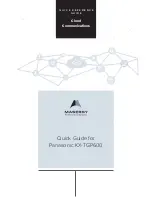
Off-Hook Signaling
2-179
Chapter 2 - Features and Operation
Weekly Night Mode Schedule
A programmable weekly night mode schedule provides for 24 hour, 7 day a week automatic
night mode operation. The system can be put into and out of night mode automatically on a
daily basis.
Digital Voice Mail (DVM)
-- The DVM Day/Night Operation can be set up to follow the same
path as the Day/Night/Special Mode for the telephone system.
Conditions
»
A station using the night key [604] can put the system into night mode.
»
The automatic schedule will override the station night key [604].
»
The attendant DND setting [631] overrides both the automatic schedule and the station
night key [604].
Off-Hook Signaling
Description
If a station has been programmed to receive direct outside line ringing and is busy on
another call, the call rings at the station using either a muted ring signal or reminder ring
depending on how the option is programmed (refer to
“CO Line - Ringing Options” on
page 2-81
). A Reminder Ring Timer provides the reminder ring every time the timer expires, as
long as the incoming CO line remains connected.
The system defaults this option to muted ringing. CO calls may also be camped-on to a busy
station and receive muted ringing.
Off-Hook Voice Over
Description
Off-Hook Voice Over (OHVO) enables station users, off-hook on a CO or intercom call, to
receive a voice announcement through the handset receiver without completely
interrupting the existing call. Your voice is only heard through the handset of the called
party’s telephone. The Voice Over is muted so it does not override or drown out the existing
conversation. The called party can connect to the two parties and carry on two independent
conversations using the handset. The called party can also respond using the text messaging
feature which sends messages to the calling party’s display.
Another method provides for the receiving station to respond to an OHVO announcement
using the MUTE feature button. This button is pressed to carry on a two-way conversation
with the OHVO initiator while still listening to the original call.
The calling station is placed in a one-time DND mode upon initiating the Voice Over.
One-time DND cannot be toggled during the OHVO call. The station receiving the
OHVO call must be off-hook and in the H mode.
Summary of Contents for Starplus Triad-S
Page 1: ...STARPLUSTM Triad S Feature Package 4 System Programming Operation...
Page 14: ...xii Contents...
Page 16: ...xiv Figures...
Page 26: ...N O T E S...
Page 192: ...2 166 Least Cost Routing Chapter 2 Features and Operation INTENTIONALLY BLANK...
Page 304: ...N O T E S...
Page 326: ...N O T E S...
Page 372: ...4 48 Uniform Call Distribution Chapter 4 Call Distribution ACD UCD...
Page 374: ...N O T E S...
Page 388: ...A 16 ICLID Call Management Tables Chapter ICLID Caller ID...
Page 390: ...N O T E S...
Page 416: ...B 28 Programming LCR Tables Chapter Least Cost Routing...
Page 418: ...N O T E S...
Page 486: ...C 70 Programming Tables Chapter Customer Database Programming...
Page 488: ...N O T E S...
Page 504: ...D 18 Part Numbers Chapter Flash Codes and Numbering Plans...
















































